The region of Umbria is one of a handful of uncrowded places still to be found in Italy. Nestled in the center of the country, an easy 2-hour drive from both Rome and Florence; it is a miracle Umbria has managed to remain under the tourist radar. Exploring towns in Umbria means venturing off the well-trodden tourist path and strolling into the heart of Italy. So slow down, grab your Italian phrasebook and enjoy the ride!
Umbria in Italy is affectionately called the green heart of Italy, a term which becomes self-explanatory when driving in from the main tourist hubs Rome & Florence.
Trading in crowded streets for small winding roads, lines of tourists for rows of vineyards, and slabs of stone – be it very beautiful and historically relevant stones, one cannot simply denounce THE Colloseum or the Duomo as ‘stones’ without adding a side note – for rolling hills with the occasional smallholding surrounded by olive groves. We are no longer in Kansas toto!
This guide will take you through 10 of the most beautiful medieval towns in Umbria, most of which are perched atop a hilltop, filled with ample restaurants boasting the best views – to be enjoyed over €3 pizza and €4 Aperol Spritz.
Please note: This post contains affiliate links, meaning I may earn a commission if you make a purchase by clicking a link (at no extra cost to you). Learn more.
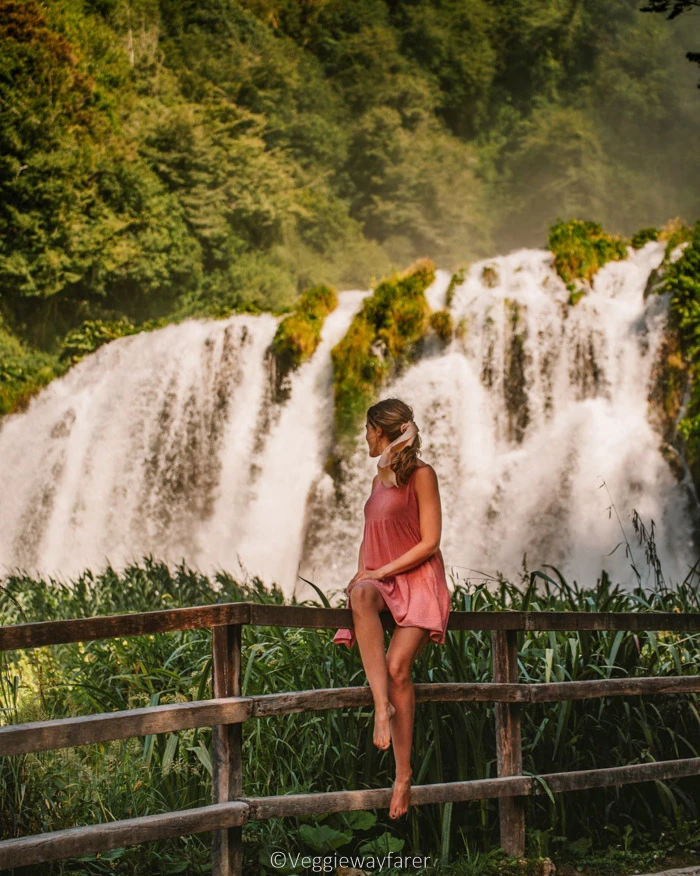

Where is Umbria & How to Get There
Umbria is one of the 20 provinces in Italy. It is located between the tourist hotspots of Tuscany (Florence) and Lazio (Rome) and can be easily reached from either.
GOOD TO KNOW | Parts of Umbria can also be visited as day trips from Rome thanks to a very good connection with direct Trenitalia trains.
Getting to Umbria by plane
Perugia (PEG) Airport is the largest airport in the region. The airport is serviced by low-cost airline Ryanair, and as such there are plenty of affordable flight connections from all major European hubs.
It is worthy to note that Rome Fiumicino (FCO) is a mere 130 kilometers (81 miles) away and Florence Peretola Airport (FLR) is around 140 kilometers (89 miles) away. The trains of Trenitalia connect both airports to the capital of the region, Perugia.
Save your pennies: Check the cheapest flights via Skyscanner
Visiting Umbria by Public Transport
Getting to Umbria (Perugia) from Rome
TRAIN: Daily trains run from Rome Fiumicino (FCO) to Perugia (1 change, 3h30, tickets start at €20/$22). Check tickets and timetable.
BUS: Four busses a day depart from downtown Rome (Rome Autostazione Tiburtina) to the center of Perugia. (1 change, 3h30 ride time, tickets start at €13/$14 (one-way)). Check tickets and timetable.
Getting to Umbria (Perugia) from Florence
TRAIN: Daily trains run from Florence Peretola Airport or Florence Santa Maria Novella Train Station (downtown) to Perugia (Direct or 1 stop, 2h, tickets starting at €15/$16.3). Check tickets and timetable
BUS: Multiple busses run between Florence Villa Costanza and Perugia Piazza Partigiani (Direct, 1h50 ride time, tickets start at €15/$16.3) Check tickets and timetable
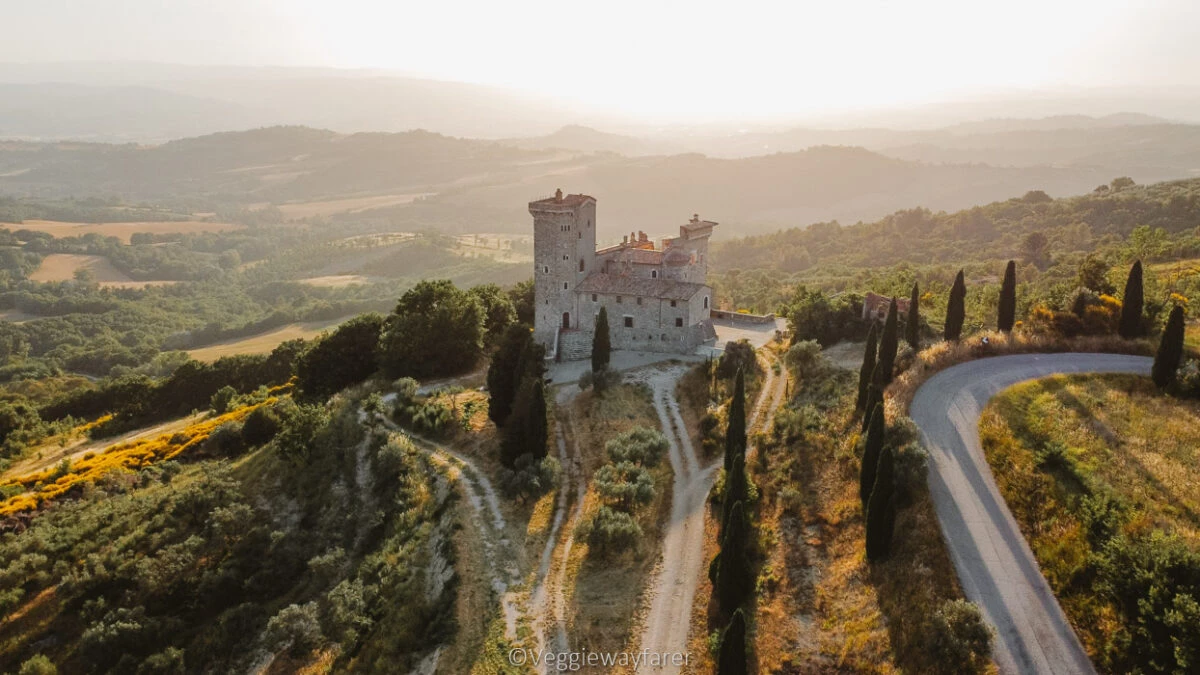
10 Medieval Umbrian Towns to Explore
Paradoxically the best plan for exploring Umbria is to have no plan. Aside from Perugia and Terni there are no other large cities in the region – the term large being relative as both cities have just over 100K inhabitants.
The region is instead dotted with little medieval towns, usually clinging for dear life to the side of a
hill. Many of these villages have a couple of thousand inhabitants and are not mentioned in any guidebook. They merit stumbling upon while you leisurely explore the Umbrian countryside. Yet as time is often finite on holiday (alas!), these are the best towns in Umbria to get a true feeling of the region: architecture, gothic churches, and ankle-biting ascents await!
Foodie Tip: Make sure to include enough time to try some of the traditional Umbrian dishes.

Most beautiful towns in Northern Umbria

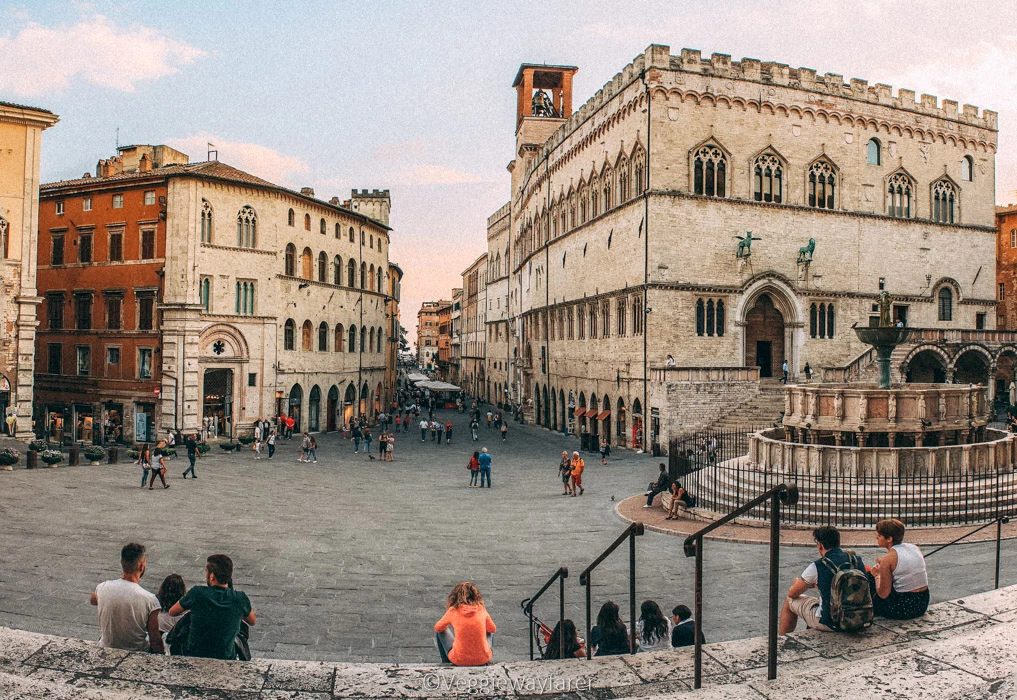
1. Perugia
Perugia is the capital of Umbria and one of the largest cities in the region. The city houses both the regional & provincial governments as well as the Public University of Perugia. The highlight of Perugia is without a doubt the medieval Centro Storico (historic center).
Walk around the Piazza IV Novembre and visit the San Lorenzo Church, take in the best panorama of the city at the Porta Sole or the Giardini Carducci, and watch the sunset from the Sciri Tower. The city holds a lot of history, which is why we decided to take a guided (& affordable) 2-hour walking tour.
Make sure to try strangozzi (a type of pasta) with truffle at the popular Osteria Cardinale. Or try your hands at making strangozzi yourself in a traditional Italian cooking class.
Perugia is one of the best towns in Umbria to use as a base for exploring the rest of the region.
Find a local agriturismo in Perugia
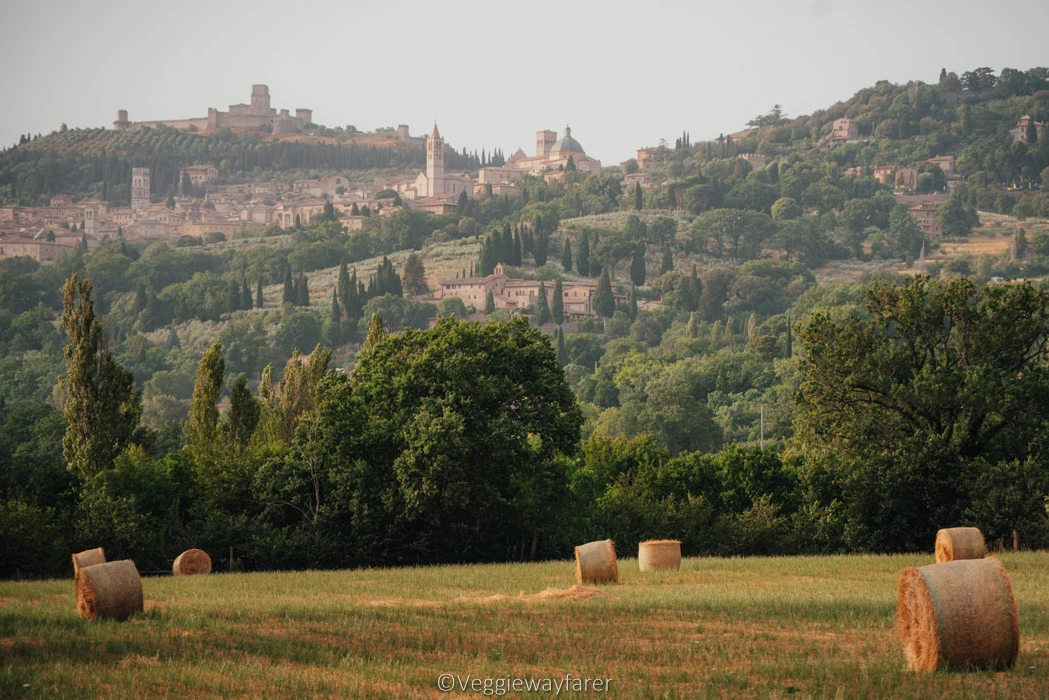
2. Assisi
Set on the slopes of Mt. Subasio, Assisi is the home and final resting place of Saint Francis, the founder of the Franciscan order.
To this day Assisi is a very important pilgrimage site both nationally and internationally and is recognized as such by UNESCO. Pilgrims flock to revere the remains of Saint Francis, who was laid to rest in the Basilica di San Francesco.
While the façade of the Basilica might exude self-effacing piety, the inside tells a different story. The large complex is decorated with exquisite frescoes, painted across the walls and ceilings of the many chapels, the detail of which could rival those of the Sistine Chapel.
It goes without saying that when out exploring Umbria, a visit to the Basilica is an absolute must. If you have some spare time make sure to pop into the other UNESCO-recognized basilica in the vicinity of Assisi: Basilica di Santa Maria degli Angeli
Visiting Assisi and the Saint Francis Basilica can be done without a guide (the town is very easy to navigate). Those looking to get a bit more of a backstory might want to consider investing in a tour.
$: VALUE FOR MONEY: A small-group 3-hour walking tour through the town of Assisi, including a guided visit of the Saint Francis Basilica and other highlights Assisi has to offer.
$$: TOP RATED TOUR: This top-rated private 3-hour walking tour explores the historical monuments of Assisi, the Saint Francis Basilica as well as a host of hidden courtyards and alleys in the town of Assisi that most tourists often overlook.
Find a locally run guesthouse in Assisi
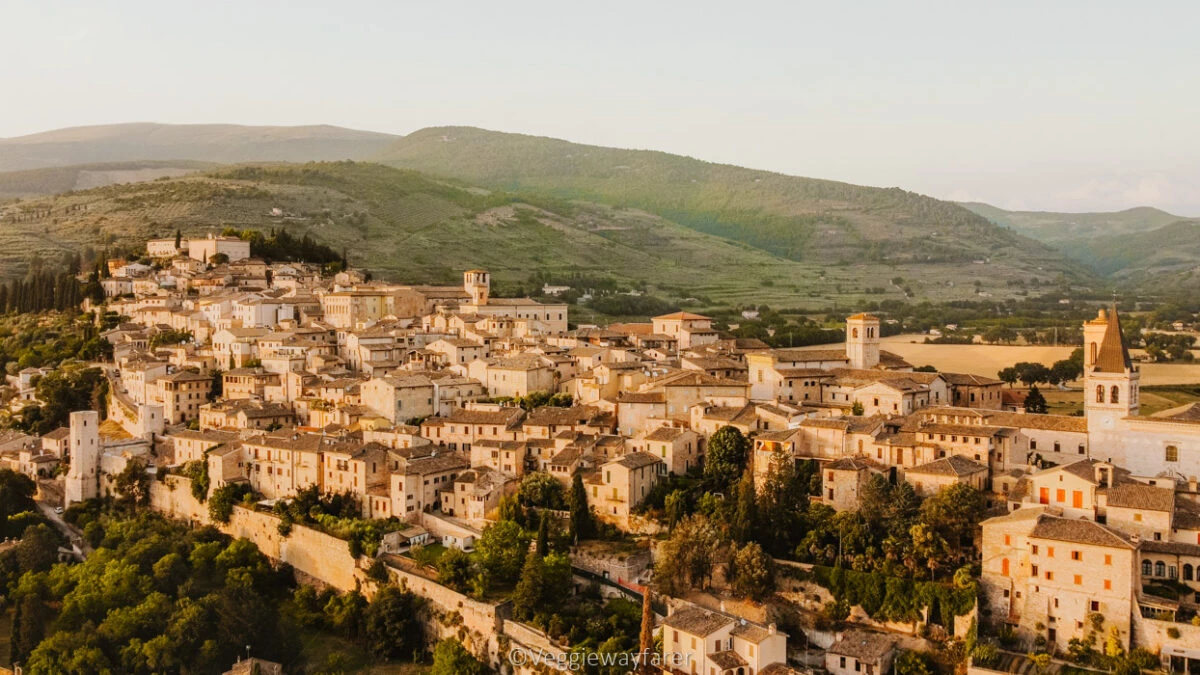
3. Spello
A short 10 kilometers (6.2 miles) away from Assisi lies the picturesque town of Spello, heralded as “the most beautiful village in Italy”. Although small in size – a mere 9000 people call it home – Spello has a lot to offer. To start off with it is one of the best towns in Umbria to get a real medieval vibe. This can be best experienced by walking through the Centro Storico (historic center). Enter the historic center through the ancient Roman gate and follow the pink signs reading Percorso Consigliato (recommended routes) to explore the town’s wonders.
Meander through ancient honey-colored houses decorated with flowers in every color of the rainbow, gaze at the vineyards sprawled out in front of the Belvedere Cappuccini and treat yourself to the local specialty: Gelato made from various flowers, the lavender flavor is worth its weight in gold!
Find a guesthouse in the Historical Centre of Spello
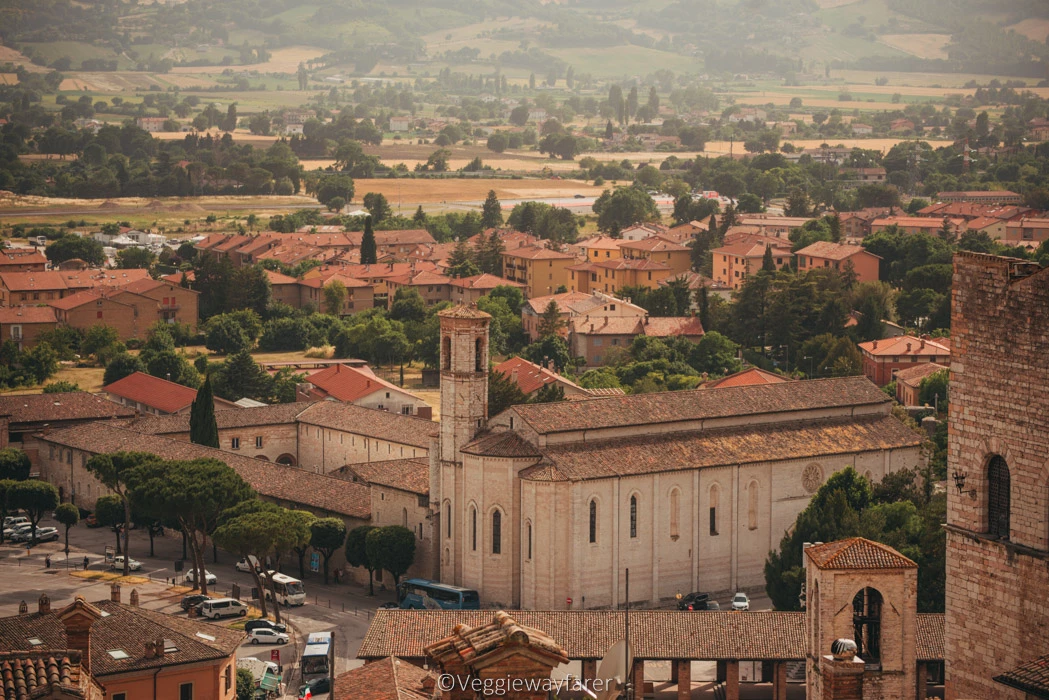
4. Gubbio
Continue exploring Umbria by driving North to the medieval town of Gubbio, home to the remains of the second-largest Roman theatre in the world – located just outside of town.
Make your way from the Roman theatre up to the Piazza Grande, and fuel up with a torta al testo before visiting the Medieval Palazzo dei Consoli. Find reprieve from the searing summer heat in the little alleyways of the Centro Storico (historic center), neatly lined with cookie-cutter 14th-century stone houses topped with terracotta-tiled rooves.
Walk up to the Gubbio Cathedral and marvel at the small but ornate baroque temple. The best views of the town are seen from the Saint’ Ubaldo Basilica, perched atop Mount Igino, and easily accessible via the Funivia Colle Eletto (return tickets cost €6/$6.5).
Tip: The Gubbio Tourist Card offers a host of discounts on the various museums in the town as well as an English audioguide that can be used to explore the city without a guide.
Find a quaint agriturismo just outside of Gubbio

Most beautiful towns in Southern Umbria

We opted to stay in a family-run agriturismo (guesthouse) just outside of Todi. Casale Dei Frontini was a great spot to stay in while we explored Southern Umbria. With a vineyard, sunflower field, and a pool with views over Todi we honestly could not have been better off. The fact it was locally run by the kindest family was the proverbial parmigiano on the pasta!
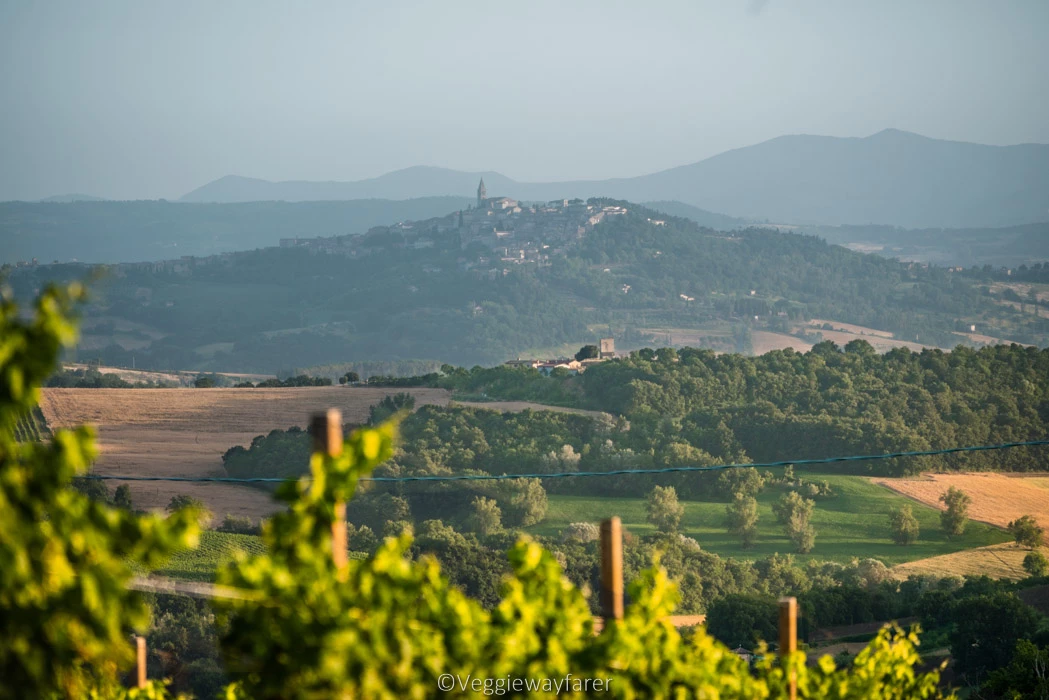
5. Todi
Todi is renowned for its unrivaled bucolic charm. Like many of its fellow Umbrian towns, it is perched on a natural pedestal above the river Tiber, surrounded by the occasional patch of sunflowers, vineyards, and iconic olive groves.
Start your visit at the Church of Saint Mary of Consolation and walk (or take the mini-bus) up to the medieval Piazza del Popolo, set aside a little time to wander around in Todi’s Gothic Cathedral. A private walking tour is a great option for those interested in the history and architecture of the town.
The best views over the town can be found from the top of the Campanile di San Fortunato, they do require a steep climb up. An alternative viewpoint can be found at Piazza Giuseppe Garibaldi – the perfect spot the watch the sunset & enjoy a glass of wine at one of the bars right on the square.
Book a romantic dinner at the Ristorante Pizzeria Cavour, where you can go straight for the €4 pizza or try the antipasti plate filled with local specialties.
Find a locally run agriturismo in Todi
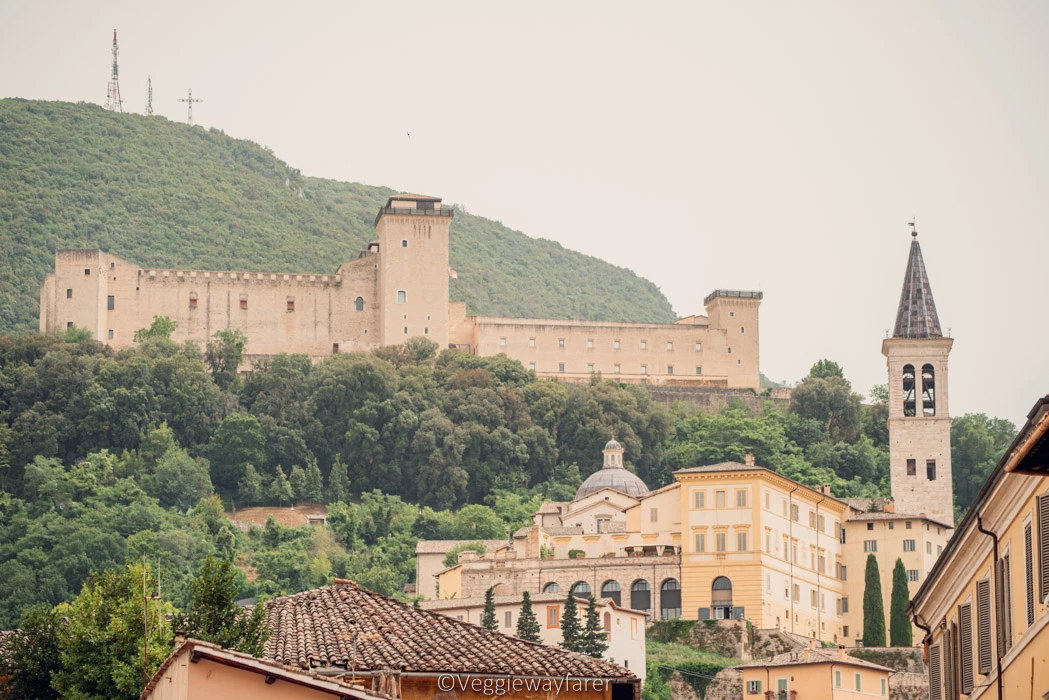
6. Spoleto
Spoleto is one of the best towns in Umbria to witness the importance of the region throughout history: Roman arches & a virtually intact Roman theatre; Romanesque cathedral and churches protected by a medieval fortress and city walls.
Various eras of history reside side by side making Spoleto a historical treasure trove to walk through. And walk you shall! Up and down the little streets, covered by medieval arches.
Grab lunch on top of the hill at one of the restaurants just under the medieval fortress to enjoy the best views over Spoleto. Make sure to leave enough room after lunch/dinner to try the local desert Crescionda.
Tip: Visiting Umbria without seeing famous waterfalls would be truly a pity! Venture 30 minutes out of Spoleto to The Marmore Falls, a 2000-year-old man-made waterfall with its very own working hours (be sure to check in advance to avoid the disappointment of turning up to a non-functioning waterfall).
Stay in the medieval historical center of Spoleto
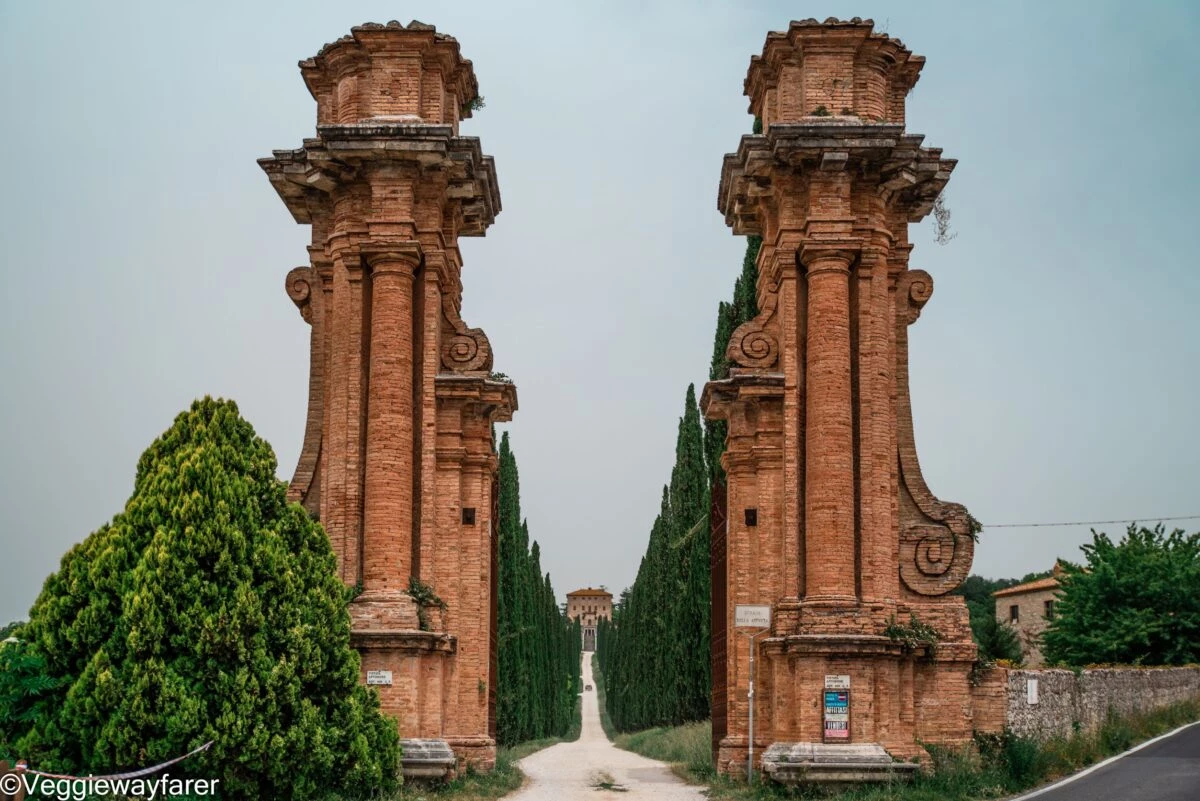
7. Amelia
The little town of Amelia is not usually on tourist routes when exploring Umbria, yet it is one of the oldest towns in the region dating back to the 11th century BC.
The centro storico (old town) can be accessed by walking through the main gate: the medieval Porta Romana. Make your way up to the Piazza Marconi and visit the beautifully preserved Cathedral of Amelia. Upon completing your visit, take some time to take in the views at the Belvedere in front of the Cathedral.
Find a guesthouse in Amelia
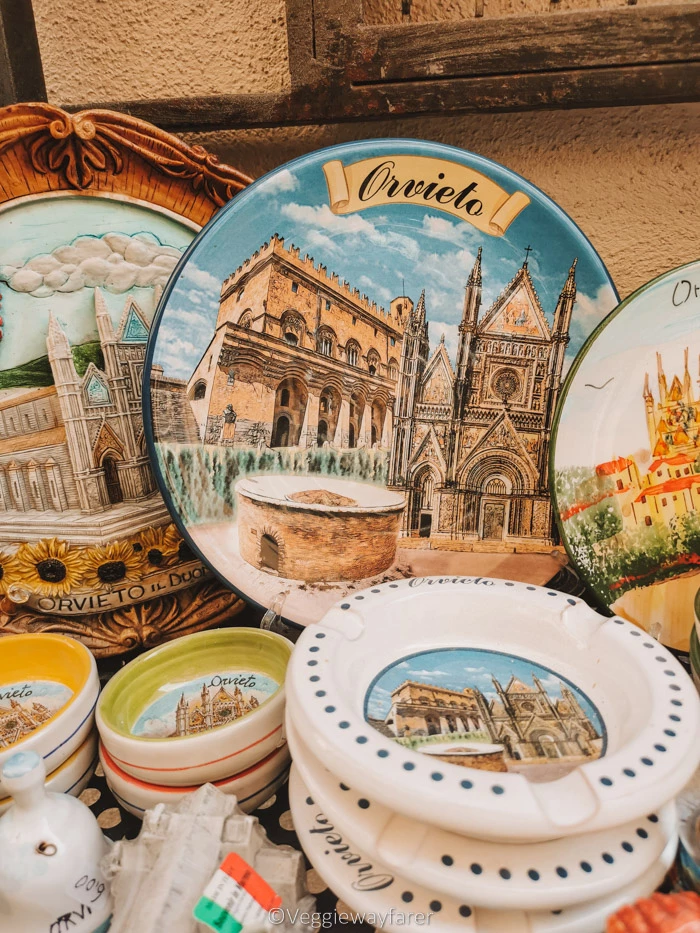
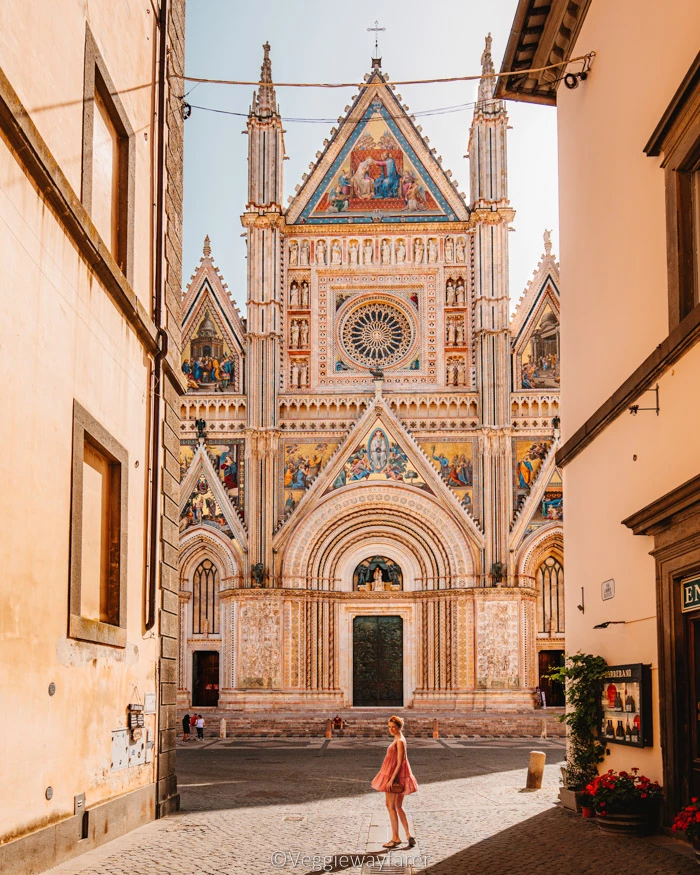
8. Orvieto
A true highlight of Umbria, Orvieto is a small but wonderful town in Umbria to spend the day in. Great for lovers of architecture and those who love getting lost in little medieval alleyways.
The centro storico (historic center) is a postcard medieval town that holds one of Italy’s most underrated wonders: A medieval Duomo encasing the show-stopping Cappella di San Brizio decorated with 15th century – slightly disconcerting –frescoes depicting The Last Judgement. While not as ornate as churches in Palermo it is certainly worth a visit!
From the Duomo walk over the Pozo della Cava and explore one of the 1200 caves that form the underground of Orvieto. Get that typical Umbrian hilltop town feel while climbing the Torre del Moro, the undisputed best viewpoint over all of Orvieto and its valley.
Combine history, architecture, and local food and wine by taking an e-bike tour or one of the many walking tours available (affordable locally run small-group walking tours or private walking tours).
Tip: Looking to get to know the Umbrian wines a little better? Book an e-bike tour from Orvieto. On this day tour, cycle to three wineries around Orvieto and taste the local specialties!
Stay in a castle: Looking to stay in a traditional Umbrian castle? Check out Hotel La Badia di Orvieto or charming Castello di Titignano.
Stay in the small town of Orvieto in one of the guesthouses
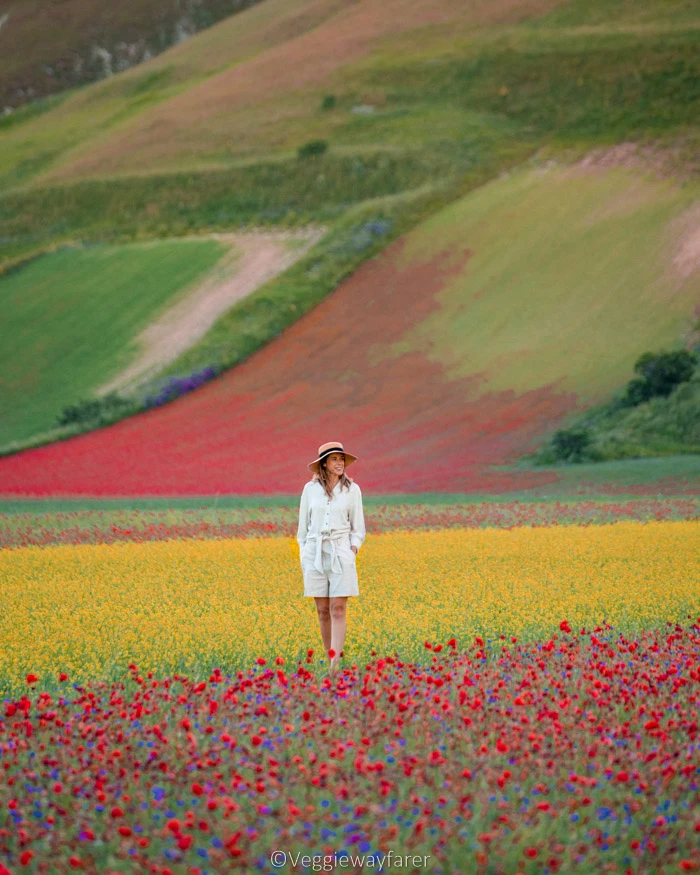

9. Norcia
The little town of Norcia was badly destroyed by the 2016 earthquake that struck Central Italy. At the time of visiting (2021), the town was still very much in disrepair with shops taking up temporary residences just outside the medieval walls.
What it lacks in solid infrastructure is made up for in utter charm and genuinely friendly locals. One of the villages in Umbria that could really use an influx of tourists, and subsequent tourist spending to help aid the repairs in the village.
This part of Umbria is known for its delicatessen: Black truffle, Castelluccio Lentils, and Prosciutto di Norcia (meat) – which can be bought in one of the many delicatessen stores in town. Non-vegetarians can try the typical Pasta a la Norcina (penne, Norcia sausage, onions, white wine, cream, pecorino cheese) in one of the local restaurants.
If you happen to be visiting Umbria during early spring, drive 35 minutes east from Norcia towards the plains of Castelluccio di Norcia to catch the fiorita (the flowering of the lentil fields) which is without a doubt one of the most beautiful natural attractions in Italy.
Find a great guesthouse in Norcia
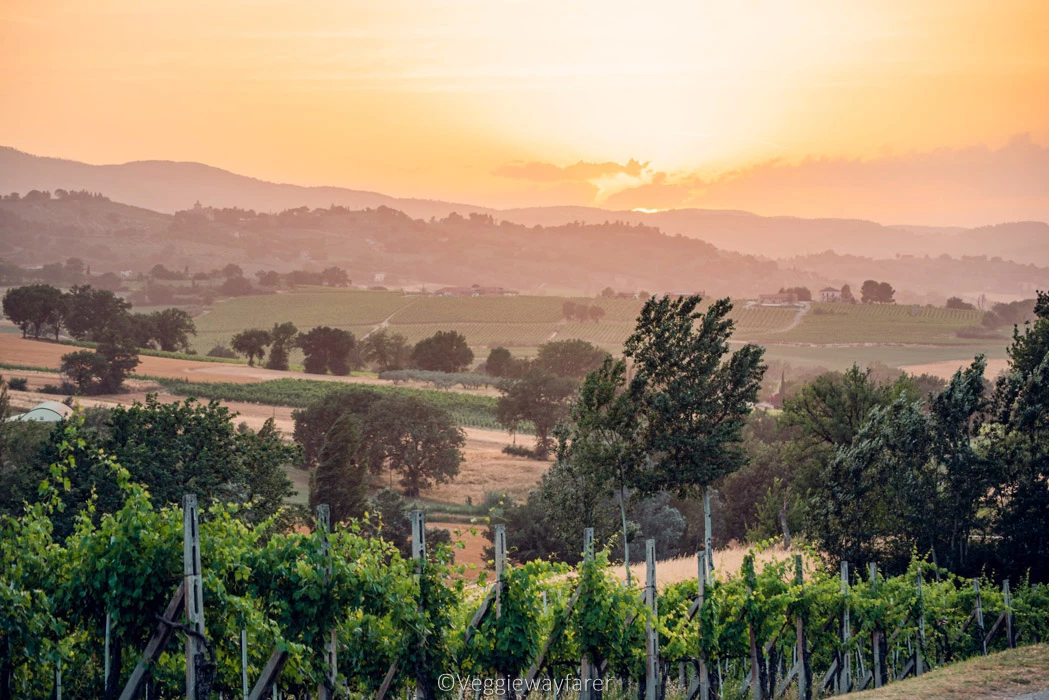
10. Montefalco
Surrounded by vineyards as far as the eye can see, with an exquisite view over the plains of Topino sits the hilltop town of Montefalco. One of the few medieval towns in Umbria where wine was produced both in and outside of the city’s protective walls for centuries.
If you are looking for a wine tasting, Montefalco might just be one of the best towns in Umbria to do so: Sagrantino di Montefalco and Rosso di Montefalco are both cultivated in the region. Take a guided tour combining the various vineyards or look up your favorite wine producer and give them a ring. Chances are they are more than happy to give you a private tour of their vineyard. An integral part of exploring Umbria is without a doubt savoring the local cuisine.
Stop by the restaurant of TV chef Giorgio Barchiesi for a taste of true Umbrian hospitality. The menu is fixed (call upfront if you are a vegetarian/vegan) and portion sizes are extremely large so best to come hungry.
Find a locally hosted stay in Montefalco
Map of Towns and Villages in Umbria
Have a look at the interactive Google Map to get an idea of where all these beautiful Umbrian villages are located in Italy. Or take a peek at the below map.
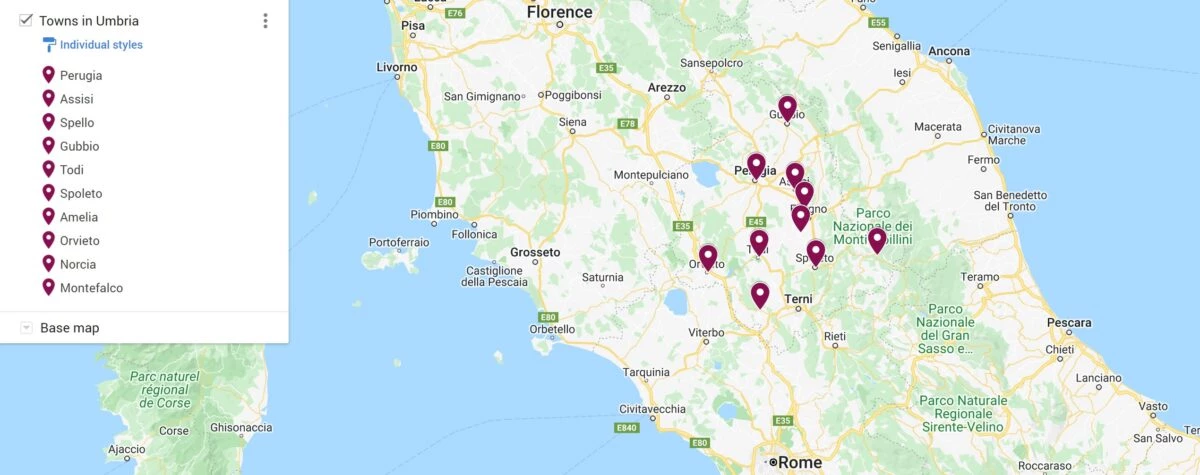
How to Get Around the Prettiest Towns of Umbria
The region of Umbria is easier to navigate via public transportation than many other provinces in Italy. Larger towns are connected through a network of buses and trains that run daily. Smaller towns in Umbria however are harder to reach with public transport.
While I am a big proponent of public transport as a means of sustainable travel, we were under a bit of a strict timeframe and we were hoping to catch a few smaller towns in the region, so in all transparency, we used the car to get around.
Public Transportation in Umbria
If you are going to rely on public transport to travel around Umbria, look into the Umbria GO pass. This pass allows you to get on (sub)urban buses, trains, and even the ferry on Lake Trasimeno. Passes can be purchased for 1,3,7, 30 days, and prices start at €15 and go up to €120 ($16.3-$130).
The pass cannot be purchased online, but it is available at the Trenitalia or Busitalia ticket offices all over Umbria and a few select sales points. Information on these select sales points was only available in Italian
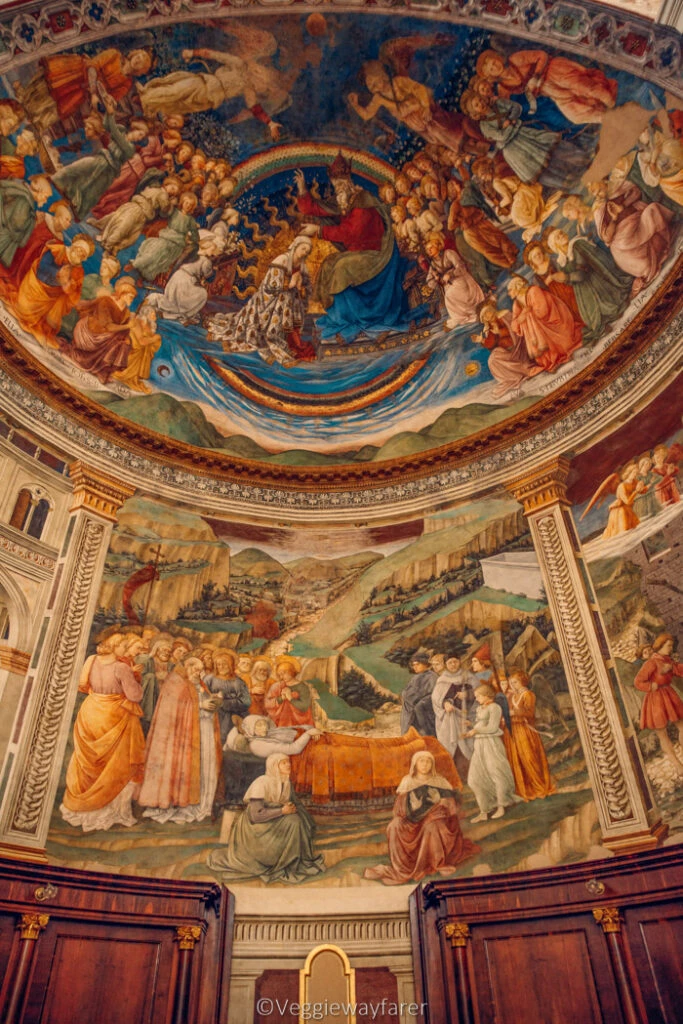

Renting a car in Umbria
Renting a car in Umbria will cost anywhere between €60 and €100 ($65-$109) euro a day depending on the type of car & insurance you choose. Prices can get expensive, compare rentals via Auto Europe and be sure to book in advance! Pickup locations are usually from the largest town in the region: Perugia
Documents needed for renting a car Umbria
- When renting a car drivers need to be at least 19 years old, drivers between 19 and 25 ýears old will most likely need to pay an additional fee (young driver surcharge)
- Valid Drivers Licence: Renting a car from outside of Europe? You will need to have an International Drivers Permit (IDP)
- Insurance: According to Italian Law, you need to be in possession of a Collision Damage Waiver and Theft Protection insurance for your car. These usually come in the standard rental package, though best to check in advance.
What type of car should I rent to travel around Umbria
There are not many electric charging points in Umbria, most of the charging points that are available are located around Perugia (check map).
If you intend to be driving inside the towns in Umbria I highly recommend getting a small car. The medieval towns were not built with cars in mind and the small roads are anything but easy to navigate (even in a small car).
Watch out: Most historical towns in Umbria are closed off during select hours of the day. Look for signs indicating ZTL (low emission zone) at the entrance of the town. This will tell you exactly when you can/cannot drive in the historical center. Every town we visited had ample parking on the outskirts so we simply popped the car there and walked into the historical center.
Find the cheapest option: Check the various options on Auto Europe and compare prices.
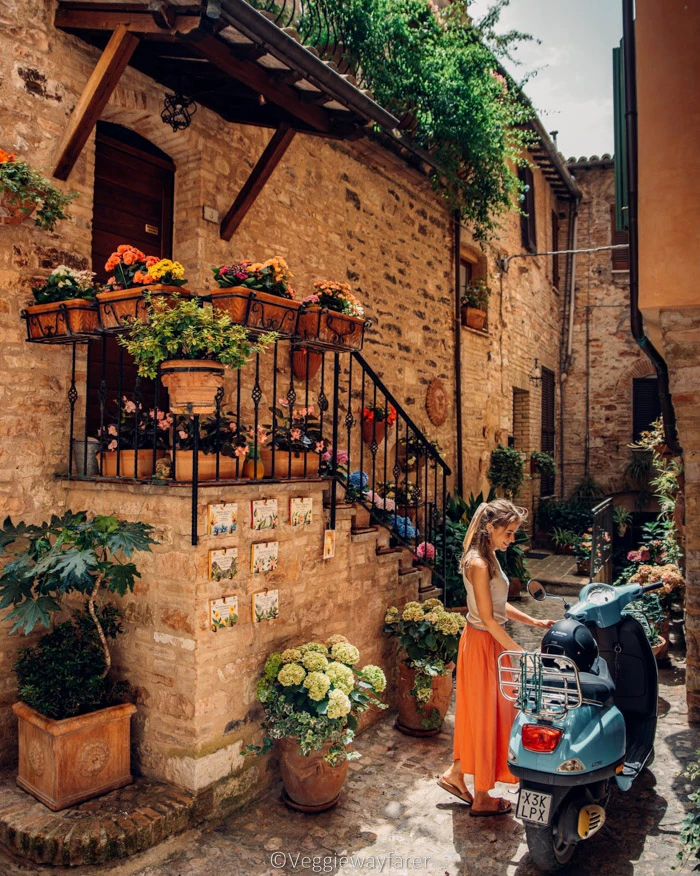

Is it Worth Taking a Tour to the Various Villages in Umbria?
If you are looking to dip your toe into the region of Umbria from Rome or Florence or want to get a deeper understanding of the region, then taking a tour is worth it! Below are a select few locally run tours that will allow you to explore Umbria.
Tours to towns in Umbria leaving from Rome & Florence
$: ASSISI & ORVIETO DAY TOUR: The UNESCO-classified towns of Assisi and Orvieto are the undisputed starlets of the region and by far the prettiest towns in Umbria to visit. This full-day tour includes a local lunch and tasting of Umbrian wines as a visit to a few hidden gems in Umbria. Departs from Rome.
$: ASSISI & CORTONA DAY TOUR: This full-day tour takes you to the UNESCO-classified village of Assisi where you will visit the Basilica of San Francesco d’Assisi and the much lesser-known Santa Maria degli Angeli. The next stop is the Etruscan town of Cortona with its renowned panoramic views. Departs from Florence.
Tours to villages in Umbria leaving from locations in Umbria
$: E-BIKE TOUR ORVIETO: Bike from Orvieto to the cliff-top village of Civita and explore the very best of the beautiful Umbrian countryside, castles, and food. A delicious local lunch is included in the price of the tour. Departs from Orvieto.
$$: BIKE AND WINE TASTING: Explore the Umbrian countryside on a bike! Ride through cobblestoned streets, the lush countryside, and all the way to a small, locally run vineyard to taste the very best Umbrian wines. A traditional lunch is included in the tour. Departs from Torre del Colle.
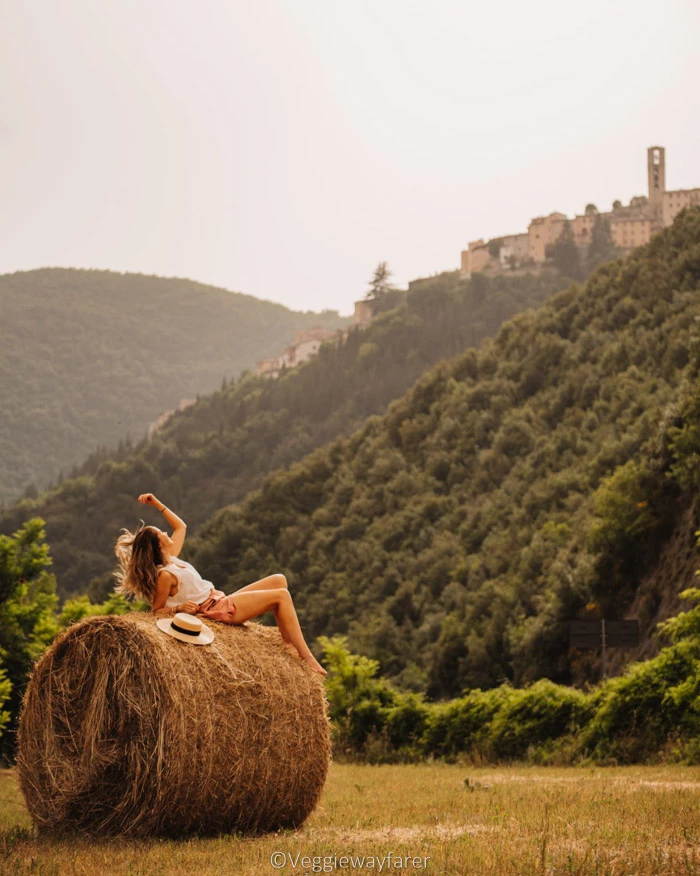
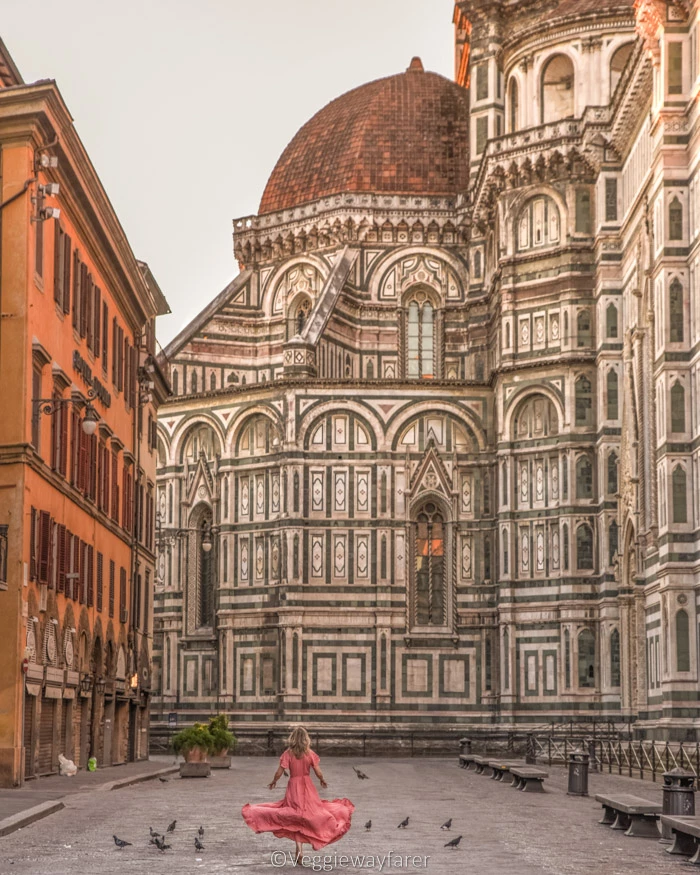
Exploring Umbria vs Exploring Tuscany
In truth, both regions are very similar in geography, history, and cuisine. Tuscany is the poster child for “la dolce vita”, many a-movie depicts a classic Fiat 500 car driving through the bucolic landscape of Tuscany: winding roads, lined with cypresses and vineyards, dotted with rustic agriturismo run by an Italian nonna (grandma).
The stark reality is, that while this might have been Tuscany many years back. These days the region is positively heaving with tourists on their quest for the true Dolce Vita and paying a hefty price for it. The region is still very beautiful, and those who seek will still find authenticity though it is becoming increasingly hard.
Exploring Umbria and driving through the many little towns in Umbria however, will provide you with ample opportunity to catch a glimpse of that traditional Italian way of life. Umbria is perfect for those looking to slow travel and immerse themselves in the local culture.
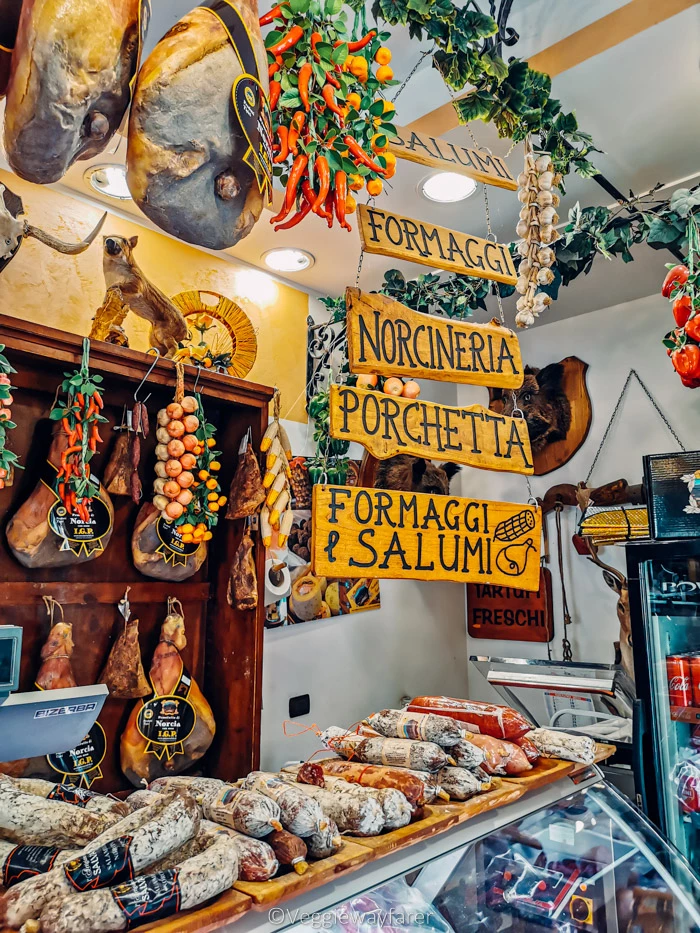

Visiting Umbria Travel Tips
I truly hope this guide has convinced you to travel to Umbria and explore all this region has to offer. A few additional tidbits of information on what foods to try, when to visit and a budget estimation can be found in the below section.
Foods in Umbria to try
Umbria is the capital of the slow food movement in Italy. In short, it means plenty of organic foods (farm-to-table), made using age-old traditional recipes.
Umbrian food is delicious and offers a great variety for both vegetarians and non-vegetarians alike. These are some of the traditional Umbrian dishes to try on your trip through the region:
- Farrecchiata di roveja: Delicious lentil soup
- Torta al testo: The traditional focaccia of the region
- Pasta alla norcina: Pasta with onion, garlic, pork sausage, ricotta cheese, black pepper, and local black truffle
- Strangozzi: A typical pasta from Spoleto (to be eaten with norcina sauce or truffles)
Is visiting Umbria expensive?
As Umbria is a more off-the-beaten-path region in Italy, it is a lot less expensive.
FOOD: Our budget was €15 per meal/person which was more than enough. Often lunch even came in under budget. To give you an example a pizza Marguerita will cost €4 (compared to €8 – €12) in Rome and Florence.
ACCOMMODATION: Hotels and Agriturismo will cost around €50-€100/$55-$109 a night (for 2 people), with city centers being on the higher end of the budget and accommodations in smaller towns being on the lower end of the budget.
Go local: Many local agriturismo are not on large booking sites. Try searching “agriturismo Umbria” to find locally run hotels and book directly via them.
Best time to explore Umbria
Umbria has something to offer travelers in each season, though it depends on what you are looking to get out of your holiday, my personal favorite seasons to visit Italy’s green lung are in spring and autumn: temperatures are mild and vegetation lush.
SPRING: Average temperatures vary between 15°C/59°F (March) and 25°C/77°F (May). Bring a sweater with you as the evenings tend to get chilly.
SUMMER: Average temperatures hover around 30°C/86°F. Plan to explore in the morning and after 4.00 PM, spend the warmest hours of the day relaxing in your agriturismo. The beginning of summer has the hills of Umbria carpeted in sunflowers as far as the eye can see.
AUTUMN: Average temperatures vary between 26°C/79°F (September) to 15°C/59°F (November). Enjoy mild temperatures and no tourists! This is the season the grapes and olives are harvested in the region. Wine lovers have ample opportunities to partake in the harvesting of grapes at local vineyards (book in advance).
WINTER: Average temperatures hover between 9°C/48°F (December) and 11°C/52°F (February). It does on occasion freeze and the region is known to get snow. If you are visiting in winter, make sure to bring plenty of warm clothes.
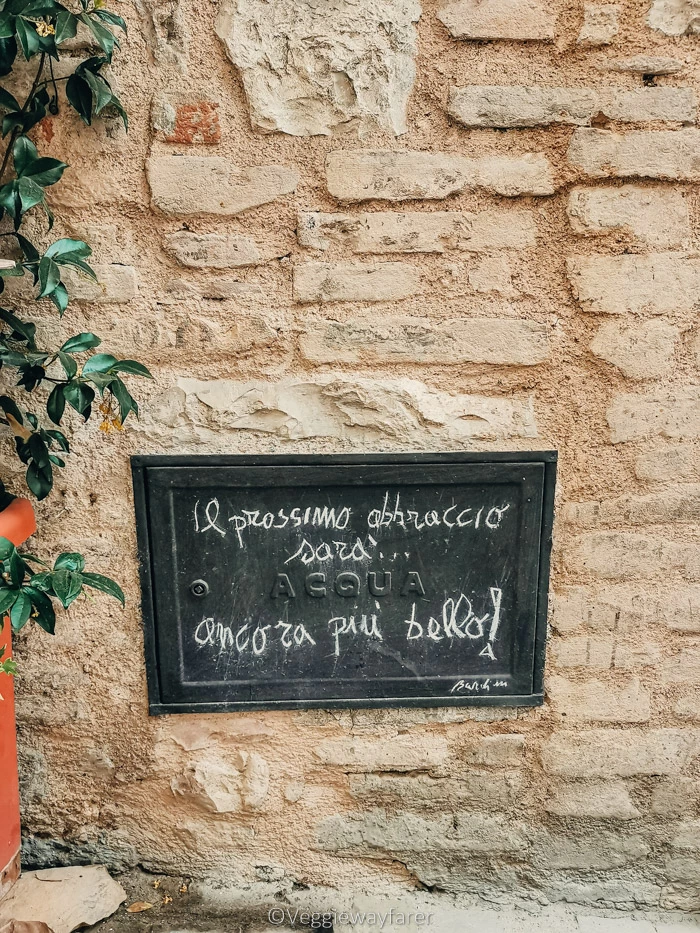

Sustainable & Responsible Tourism in Umbria
HEAD OFF THE BEATEN PATH: Italy has a wealth of amazing little towns, cities and natural attractions to offer the discerning traveler. Yet, the vast majority of people tend to stick to the same Itinerary. Umbria has managed to remain wonderfully authentic and is a great place to explore the tiny town.
TAP WATER: Tap water is drinkable all over Italy. Bring a reusable water bottle with you on your travels.
DRESS CODE: Most visitors will pop into at least one church when in Italy if only to see the majestic architecture. Make sure to dress appropriately for your visit: Cover your shoulders and knees.
STAY LOCAL: Heading out to explore a few of the natural parks in Italy, or embark on a hike in the epic Dolomites? Make sure to leave not a single piece of trash behind.
TRY DOP PRODUCTS: Products labeled with DOP or the “Denominazione di Origine Protetta” are regional products using ingredients coming from a specific location and/or family and adhere to the highest standard of quality.
Towns in Umbria in Conclusion
Umbria is a true hidden gem in Italy, wedged between two of the country’s main tourist attractions it is easy to add to any Rome or Tuscany Itinerary and will cost half of the budget.
Visiting Umbria is perfect for the traveler looking to slow down and get a true taste of the Italian “Dolce Vita”, served with a side of delicious Truffle Pasta and washed down with the very best Umbrian wine. Enjoy!
MORE TRAVEL RESOURCES FOR VISITING ITALY
NORTHERN ITALY: Northern Italy road trip one to two-week itinerary
DOLOMITES: Most beautiful lakes in the Dolomites
DOLOMITES: Find the perfect accommodation in the Dolomites
SICILY: Picture perfect Sicilian villages you simply cannot miss
SICILY: Where to stay in Sicily for a relaxing getaway
SICILY: Traditional Sicilian dishes to try on your trip to Sicily

Towns in Umbria: Pin it
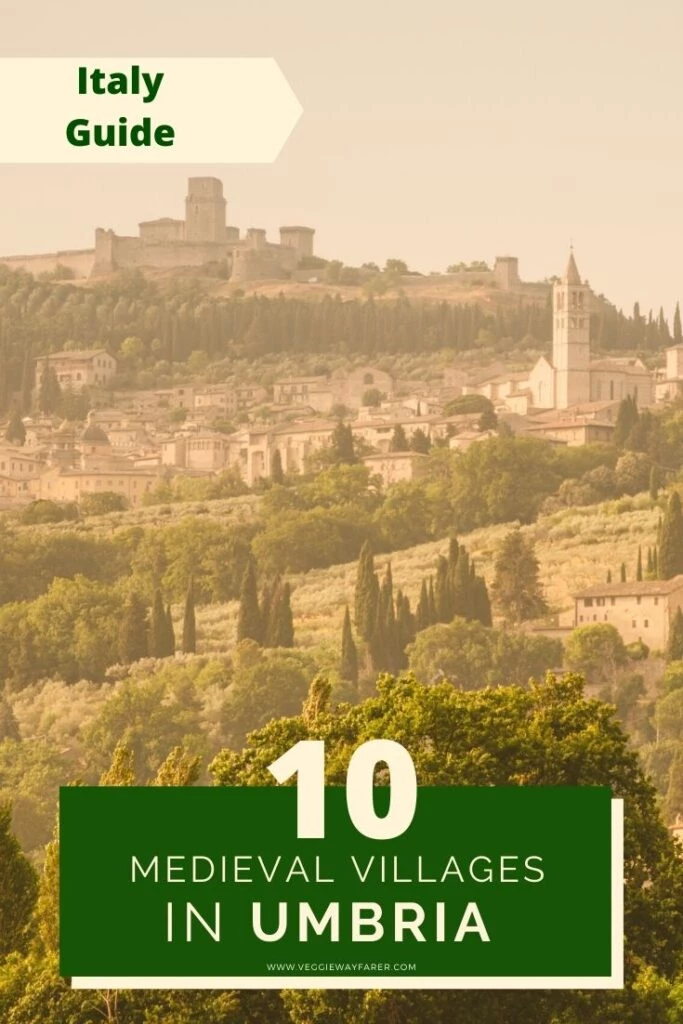


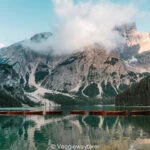



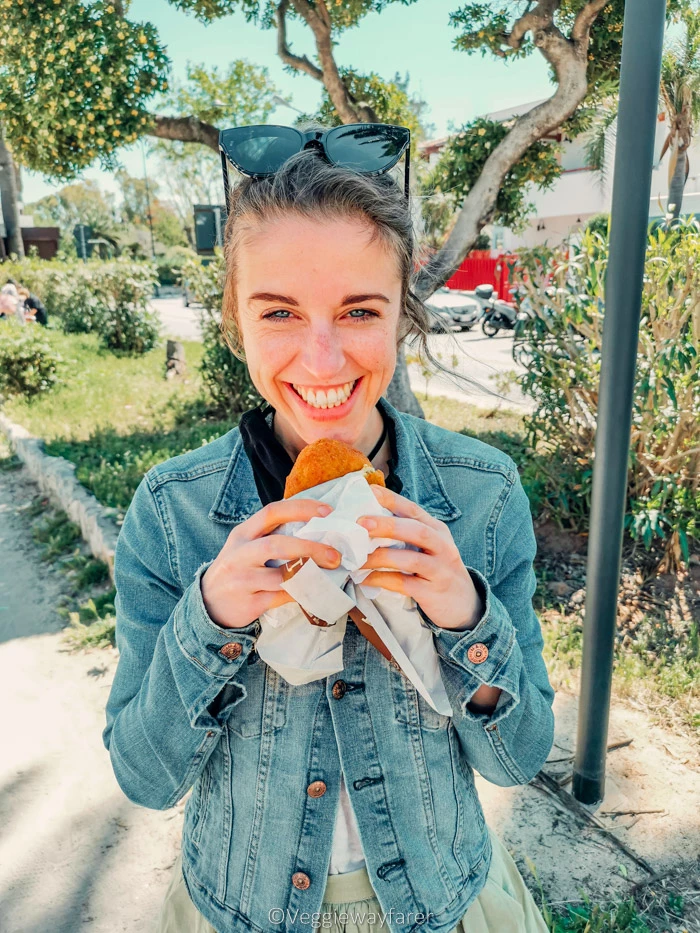


Thanks for taking the time to put this comprehensive and useful guide together–you have inspired me to visit Umbria!
Thanks Deborah for your kind words. I hope you enjoy beautiful Umbria just as much as I did!
Hello, i am planning to spend a month in Spoleto to attend an Italian language course at the ArteLingua School in the month of September 2023.
I am expected to have a full schedule Monday through Friday but will have some time on the weekend to explore on my own the surrounding villages of Umbria ( Spello, Gubbio, Todi,Orvieto, Norcia, Montefalco, Amelia)-
I am reaching out to find out whether you could provide me with travel services to these villages.
Thank you for your prompt reply.
Hi, I do not unfortunately. But getting around Umbria is pretty easy with busses :).